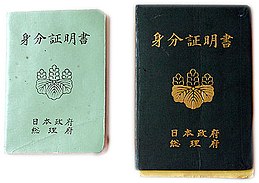geo.wikisort.org - Island
Mainland Japan (内地, naichi, lit. "inner lands") is a term to distinguish the area of Japan from its outlying territories. It was an official term in the pre-war period, distinguishing Japan and its colonies in the Far East. After the end of World War II, the term became uncommon, but still is used as an unofficial term to distinguish the area of Japan from the Ryukyu Islands or Hokkaidō.
Native name: 内地 | |
|---|---|
 Passports for passengers between Mainland Japan and Okinawa during 1952–1972. | |
| Geography | |
| Location | Japan |
| Demographics | |
| Ethnic groups | Japanese people |
The literal Japanese meaning might best be translated as inner Japan or inner lands. The term "mainland" is an inaccurate translation because mainland is usually the continental part of a region, as opposed to the islands.
It is also somewhat confusing as Mainland Japan is defined to consist of several major islands (Hokkaidō, Honshū, Kyūshū, and Shikoku) and many minor ones. The term Mainland Japan is also sometimes used to translate Honshū, the largest island.
Historical usage
In the Japanese Empire of the pre-war period, naichi referred to the mainland of the empire. The other territories of the empire was called gaichi (外地, lit. "outer lands").
The Meiji Constitution's Article 1 of the Common Law (共通法) enumerates the territories with legal jurisdictions namely:
Naichi
Naichi (内地, mainland) were the territories under direct control of the government. It consisted of the following:[1][citation needed]
- Karafuto Prefecture (after 1943)
- Chishima Islands
- Hokkaidō
- Honshū
- Shikoku
- Kyūshū
- Izu Islands
- Ogasawara Islands
- Okinawa
- Minor outlying islands around them
Gaichi
These territories were called gaichi (外地, lit. "outer lands"). They were part of the Empire of Japan, but not under direct control by the central government.[2]
- Chōsen (Korea)
- Taiwan
- Kwantung Province
- Karafuto (until 1943)
- South Seas Mandate.[3]
Although it has never been abolished, the Common Law lost effect from enforcement after Japan lost all the former colonies, or gaichi as a result of World War II.
Modern usage
The residents of Hokkaidō and Okinawa occasionally use naichi to refer to the "mainland", excluding these areas. The colloquial usage is officially "incorrect", as both areas are legally within naichi. In Hokkaidō, the official term that refers to Japan except Hokkaidō is dōgai (lit. outside of Hokkaidō).[citation needed] With dōgai becoming common even in colloquial use, naichi ceases to be used.[citation needed]
The term "main islands" (本島 hontō) is used for Hokkaido, Honshu, Kyushu, Shikoku and Okinawa. The other estimated 6,847 smaller islands are called 'remote islands' (離島 ritō).[4]
See also
- Home Islands
- Mainland China
- China proper
References
- Japanese page about Mainland Japan (内地, Inland)
- Japanese page about Mainland Japan (内地, Inland) and page about Gaichi 外地
- Nakano Bunko 中野文庫. "Kyōtsūhō 共通法" (in Japanese). Archived from the original on December 23, 2014. Retrieved December 10, 2011.
- "離島とは(島の基礎知識) (what is a remote island?)". MLIT (Ministry of Land, Infrastructure, Transport and Tourism) (in Japanese). Ministry of Land, Infrastructure, Transport and Tourism. August 22, 2015. Archived from the original (website) on November 13, 2007. Retrieved August 9, 2019.
MILT classification 6,852 islands(main islands: 5 islands, remote islands: 6,847 islands)
На других языках
- [en] Mainland Japan
[it] Giappone continentale
Giappone continentale (内地 naichi?, lett. "terre interne") è un termine usato per distinguere l'area del Giappone dai suoi territori remoti. Era un termine ufficiale nel periodo prebellico, distinguendo il Giappone e le sue colonie in Asia orientale. Dopo la fine della Seconda guerra mondiale, il termine divenne poco comune, ma si usa ancora come termine ufficioso per distinguere l'area del Giappone da Okinawa od Hokkaidō.Другой контент может иметь иную лицензию. Перед использованием материалов сайта WikiSort.org внимательно изучите правила лицензирования конкретных элементов наполнения сайта.
WikiSort.org - проект по пересортировке и дополнению контента Википедии